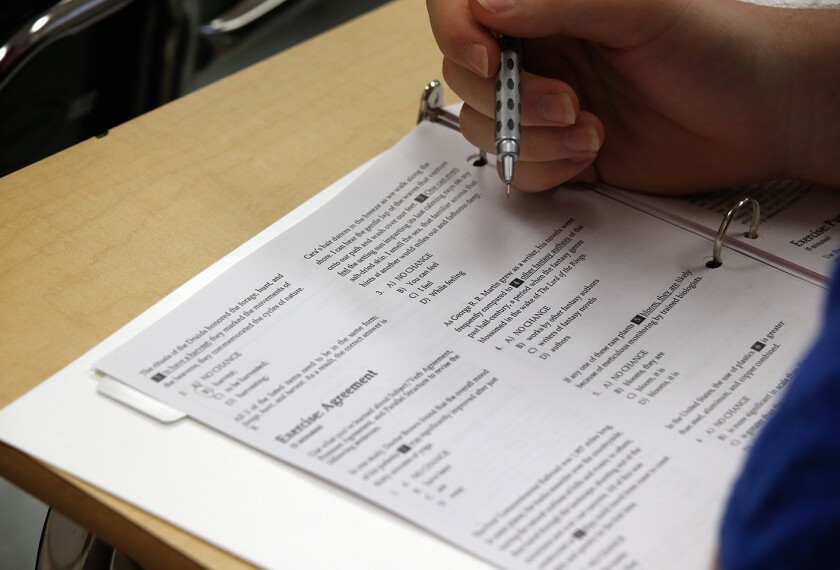In 2018, when the federal government gave states a chance to try out new forms of testing, it seemed they would be clamoring to ditch multiple-choice and short-response tests for a new breed of richer assessments.
That hasn’t happened.
Instead, the effort, made possible through the Innovative Assessment pilot under the Every Student Succeeds Act, has largely been a bust. Just seven states—Georgia, Hawaii, Indiana, Louisiana, Massachusetts, New Hampshire, and North Carolina—have applied for the pilot.
Of those states, two have not yet been approved: Hawaii and Indiana. And of the five that were approved, Georgia and New Hampshire have already dropped out, leaving just three states still pursuing the flexibility: Louisiana, Massachusetts, and North Carolina.
The Granite State’s exit from the pilot is particularly noteworthy, given that New Hampshire’s performance task assessments, which the state received flexibility to try even before ESSA passed, were a big inspiration for the overall program.
The anemic participation could have long term implications for standardized testing because the pilot was intended to serve as a bridge to different kinds of tests nationwide. After the Institute of Education Sciences studies the pilot, the secretary could allow more states—even all states—to join. But there is no deadline yet for when that study needs to be started or completed.
Now, the U.S. Department of Education is hoping to entice states to reconsider pursuing the flexibility. And they are looking for ideas of what, exactly, would encourage more takers. The agency put out a request for information earlier this month, with comments due May 1.
Participating in the pilot isn’t an easy lift
Part of the problem, according to advocates and experts? While many states were initially excited about the pilot, they had second thoughts when they looked more closely at the details.
At first, “states were like, ‘this is it, this is our moment,’ and you know, finally trying to innovate and figure out how to make assessments that are more responsive” to the needs of both teachers and students, said Lillian Pace, the vice president of policy and advocacy for KnowledgeWorks, a nonprofit organization that works to personalize learning for students
But then states realized there were big hurdles to overcome: They got no money for participating in the pilot. They had to bring the new tests statewide within five years without additional planning time, a timeline experts considered very ambitious. And even as they were working on the new tests, they would have to continue administering the old ones.
What’s more, states had to show that the results of the tests were “comparable” across districts, so that a particular score or outcome means the same thing from one district to the next. And they had to be sure that the new assessments were administered with a representative sample of students from around the state. (That means a state with a large English-learner population, such as California, would need to be sure plenty of those students had experience with an assessment before taking it statewide.)
Once states saw that long, challenging list, many decided to find avenues other than the pilot, opting to revamp their non-federally required assessments. (The feds currently require reading and math tests in grades 3-8 and once in high school.)
For instance, five states—Colorado, Connecticut, New Mexico, New York, and Vermont—began working on capstone projects and portfolios for high school graduation, according to a KnowledgeWorks analysis. Alabama, Colorado, Hawaii, Massachusetts, New Hampshire, New York, Oregon, Vermont, and Virginia considered performance assessment, which call for students to show their mastery of a particular skill or grasp of a concept in a new context.
The feds helped with those efforts by creating new grants that awarded $29 million to 10 states to help improve their assessments. States participating in the pilot were offered a leg up on their grant applications. But only one, Louisiana, ended up securing a grant.
“The federal government is investing in new and larger resources [to help] states build out new approaches to innovative assessment, yet there isn’t a policy for those states to be able to bring them to scale,” Pace said. “And that’s why we need some kind of ... fix for the [Innovative assessment] program, in order to make a more viable pathway for states.”
So how could the department use the information it gets from educators to make the program more attractive?
They could revise the rules around the program to allow for a planning year, Pace suggested. And they could make it easier to show that the data from the tests is comparable from one district to another, which has been a particularly tricky problem for states, she added.
Further flexibility might require revising the ESSA law.
Sen. Chris Murphy, D-Conn., is working on legislation to encourage more states to participate in the pilot, while also ensuring that state tests continue to help educators identify which schools or groups of students within a school are falling behind.







